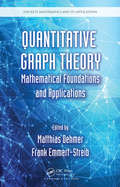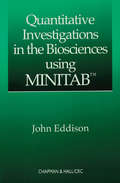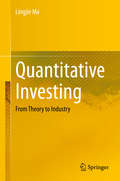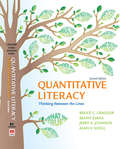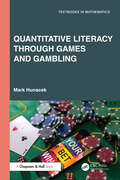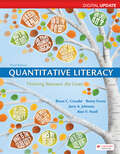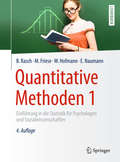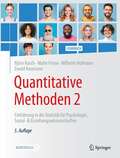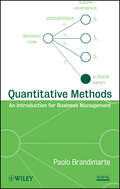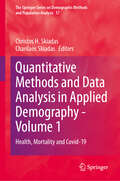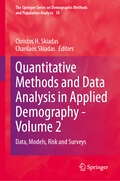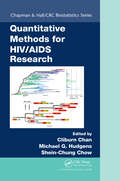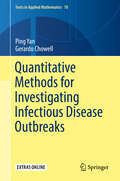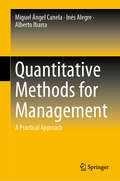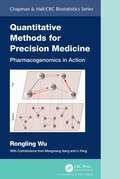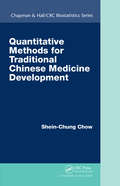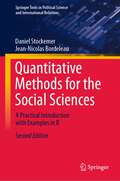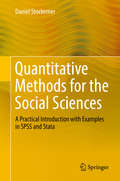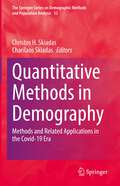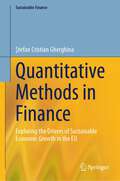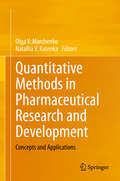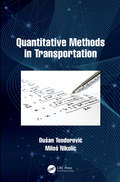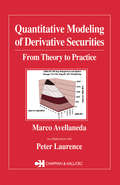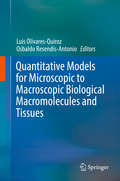- Table View
- List View
Quantitative Graph Theory: Mathematical Foundations and Applications
by Matthias Dehmer Frank Emmert-StreibThe first book devoted exclusively to quantitative graph theory, Quantitative Graph Theory: Mathematical Foundations and Applications presents and demonstrates existing and novel methods for analyzing graphs quantitatively. Incorporating interdisciplinary knowledge from graph theory, information theory, measurement theory, and statistical technique
Quantitative Investigations in the Biosciences using MINITAB
by John EddisonUntil recently, acquiring a background in the basic methodological principles that apply to most types of investigations meant struggling to obtain results through laborious calculations. The advent of statistical software packages has removed much of the tedium and many of the errors of manual calculations and allowed a marked increase in the depth and sophistication of analyses. Although most statistics classes now incorporate some instruction in using a statistics package, most introductory texts do not.Quantitative Investigations in the Biosciences using MINITAB fills this void by providing an introduction to investigative methods that, in addition to outlining statistical principles and describing methods of calculations, also presents essential commands and interprets output from the statistics package MINITAB.The author introduces the three basic elements of investigations-design, analysis, and reporting-using an extremely accessible approach that keeps mathematical detail to a minimum. He groups statistical tests according to the type of problem they are used to examine, such as comparisons, sequential relationships, and associations.Quantitative Investigations in the Biosciences using MINITAB draws techniques and examples from a variety of subjects, ranging from physiology and biochemistry through to ecology, behavioral sciences, medicine, agriculture and horticulture, and complements the mathematical results with formal conclusions for all of the worked examples. It thus provides an ideal handbook for anyone in virtually any field who wants to apply statistical techniques to their investigations.
Quantitative Investing: From Theory to Industry
by Lingjie MaThis book provides readers with a systematic approach to quantitative investments and bridges the gap between theory and practice, equipping students to more seamlessly enter the world of industry. A successful quantitative investment strategy requires an individual to possess a deep understanding of the financial markets, investment theories and econometric modelings, as well as the ability to program and analyze real-world data sets. In order to connect finance theories and practical industry experience, each chapter begins with a real-world finance case study. The rest of the chapter introduces fundamental insights and theories, and teaches readers to use statistical models and R programming to analyze real-world data, therefore grounding the learning process in application. Additionally, each chapter profiles significant figures in investment and quantitative studies, so that readers can more fully understand the history of the discipline. This volume will be particularly useful to advanced students and practitioners in finance and investments.
Quantitative Literacy
by Benny Evans Bruce C. Crauder Jerry A. Johnson Alan V. Noell"I finally understand why I need to learn some math!" says a student after finishing a course that used Quantitative Literacy. That enthusiastic response gets to the heart of how this remarkable textbook works. Quantitative Literacy shows students that they use math in their everyday lives more than they realize, and that learning math in real-world contexts not only makes it easier to get better grades, but prepares them for decisions they'll face about money, voting and politics, health issues, and much more. The authors draw on a wide range of examples to give students basic mathematical tools-- from sports to personal finance to sociopolitical action to medical tests to the arts--with coverage that neatly balances discussions of ideas with computational practice.
Quantitative Literacy Through Games and Gambling (Textbooks in Mathematics)
by Mark HunacekThis book was developed to address a need. Quantitative Literacy courses have been established in the mathematics curriculum for decades now. The students in these courses typically dislike and fear mathematics, and the result is often a class populated by many students who are unmotivated and uninterested in the material. This book is a text for such a course; however, it is focused on a single idea that most students seem to already have some intrinsic interest in and is written at an accessible level. It covers the basic ideas of discrete probability and shows how these ideas can be applied to familiar games (roulette, poker, blackjack, etc.). The gambling material is interweaved through the book and introduced as soon as the necessary mathematics has been developed. Throughout, mathematical formalism and symbolism have been avoided, and numerous examples are provided. The book starts with a simple definition of probability, goes through some basic concepts like combining events and expected value, and then discusses some elementary mathematical aspects of various games. Roulette is introduced very early on, as is the game of craps, which requires some knowledge of conditional probability. Other games like poker, blackjack, and lotteries, whose study requires some rudimentary combinatorics, come shortly thereafter. The book ends with a brief introduction to zero-sum games, with some attention paid to the use of these ideas in studying bluffing. In addition to discussion of these traditional games, the author motivates probability by talking about a few applications in legal proceedings that illustrate how mathematics has been misused in the courtroom. There is also a discussion of the Monty Hall problem, a nonintuitive result in probability that has an interesting and colorful history. Hopefully, students studying from this text will find that mathematics is not as horrible as they have always thought and offers some interesting applications in the real world. This should perhaps be the goal of any quantitative literacy course.
Quantitative Literacy, Digital Update: Thinking Between the Lines
by Bruce Crauder Benny Evans Alan Noell Jerry JohnsonTransform students into informed consumers of the quantitative information they read, see, and hear every day.With Quantitative Literacy: Thinking Between the Lines, you’ll be smarter about the math you use every day, making better decisions about money, voting and politics, health issues, and much more.
Quantitative Methoden 1: Einführung in die Statistik für Psychologen und Sozialwissenschaftler (Springer-Lehrbuch)
by Wilhelm Hofmann Björn Rasch Malte Friese Ewald NaumannWelche Angst plagt die meisten Studienanfänger im Psychologie-Studium? Die Angst vor der Statistik-Prüfung! Hier schaffen wir Abhilfe, denn die Statistik ist ein wichtiges Handwerkszeug, um zu verstehen, wie die Psychologie Erkenntnisse gewinnt und ihre Forschungsergebnisse zu bewerten sind – und wenn die Statistik verständlich erklärt ist, gibt es keinen Grund zur Panik! Mit den beiden Bänden Quantitative Methoden 1/2 meistern Sie die Grundlagen der Statistik! Anwendungsbezogen und verständlich werden hier die Inhalte der Vorlesungen Quantitative Methoden, Statistik oder Methodenlehre erklärt. Band 1 umfasst die Themen deskriptive Statistik, Grundzüge der Inferenzstatistik und den t-Test sowie Zusammenhangsmaße und Regression. Mit Verständnisfragen und Antworten, Glossar der wichtigsten Statistik-Begriffe und Verteilungstabellen. – Außerdem mit vielen kostenlosen Zusatzmaterialien auf der begleitenden Lehrbuch-Website: Mehrere hundert Extraseiten mit Anleitungen zur konkreten Durchführung der behandelten statistischen Verfahren mit SPSS und R, Informationen zur Durchführung von Teststärkeanalysen und Stichprobenumfangsplanungen mit G*Power sowie Beispielaufgaben – alles inklusive notwendiger Datensätze. Und ganz NEU in der 4. Auflage: Zahlreiche Erklärungsvideos zu wichtigen Formeln und Zusammenhängen!
Quantitative Methoden 1: Einführung in die Statistik für Psychologie, Sozial- & Erziehungswissenschaften
by Wilhelm Hofmann Björn Rasch Malte Friese Ewald NaumannDieses Lehrbuch macht Dich fit für die Statistik-Prüfung – hier geht es um die Deskriptive Statistik sowie um die ersten Schritte in Inferenzstatistik, z.B. den t-Test. Also Dinge, die in vielen sozialwissenschaftlichen Studiengängen, wie z.B. Psychologie, Soziologie oder Erziehungswissenschaften, auf dem Lehrplan stehen. Vielen macht die Statistik Angst – aber mit diesem Buch wirst Du die Prüfung meistern, weil Dir hier alles sehr verständlich und ergänzt durch kostenfreie Videos und umfangreiche zusätzliche Materialien erklärt wird.
Quantitative Methoden 2: Einführung in die Statistik für Psychologie, Sozial- & Erziehungswissenschaften
by Wilhelm Hofmann Björn Rasch Malte Friese Ewald NaumannDieses Lehrbuch macht Dich fit für die Statistik-Prüfung – hier geht es u.a. um Varianzanalysen und Verfahren für Rang- und Nominaldaten. Also Dinge, die in vielen sozialwissenschaftlichen Studiengängen, wie z.B. Psychologie, Soziologie oder Erziehungswissenschaften, auf dem Lehrplan stehen. Mit diesem Buch wirst Du die Prüfung meistern, weil Dir hier alles sehr verständlich und ergänzt durch kostenfreie Videos und umfangreiche zusätzliche Materialien erklärt wird.
Quantitative Methods
by Paolo BrandimarteAn accessible introduction to the essential quantitative methods for making valuable business decisionsQuantitative methods-research techniques used to analyze quantitative data-enable professionals to organize and understand numbers and, in turn, to make good decisions. Quantitative Methods: An Introduction for Business Management presents the application of quantitative mathematical modeling to decision making in a business management context and emphasizes not only the role of data in drawing conclusions, but also the pitfalls of undiscerning reliance of software packages that implement standard statistical procedures. With hands-on applications and explanations that are accessible to readers at various levels, the book successfully outlines the necessary tools to make smart and successful business decisions.Progressing from beginner to more advanced material at an easy-to-follow pace, the author utilizes motivating examples throughout to aid readers interested in decision making and also provides critical remarks, intuitive traps, and counterexamples when appropriate.The book begins with a discussion of motivations and foundations related to the topic, with introductory presentations of concepts from calculus to linear algebra. Next, the core ideas of quantitative methods are presented in chapters that explore introductory topics in probability, descriptive and inferential statistics, linear regression, and a discussion of time series that includes both classical topics and more challenging models. The author also discusses linear programming models and decision making under risk as well as less standard topics in the field such as game theory and Bayesian statistics. Finally, the book concludes with a focus on selected tools from multivariate statistics, including advanced regression models and data reduction methods such as principal component analysis, factor analysis, and cluster analysis.The book promotes the importance of an analytical approach, particularly when dealing with a complex system where multiple individuals are involved and have conflicting incentives. A related website features Microsoft Excel® workbooks and MATLAB® scripts to illustrate concepts as well as additional exercises with solutions.Quantitative Methods is an excellent book for courses on the topic at the graduate level. The book also serves as an authoritative reference and self-study guide for financial and business professionals, as well as readers looking to reinforce their analytical skills.
Quantitative Methods and Data Analysis in Applied Demography - Volume 1: Health, Mortality and Covid-19 (The Springer Series on Demographic Methods and Population Analysis #57)
by Christos H. Skiadas Charilaos SkiadasThis first volume of two provides quantitative techniques to estimate the healthy life years lost by expanding the classical life tables to include the proportion with disability calculated from life tables, along with a final part using the Sullivan method. The provided templates apply immediately to the life tables from the WHO, HMD, Eurostat and other life table providers. Furthermore, the possibility of creating new health indicators is explored along with Covid-19 pandemic management. A part of this book is devoted to mortality, epidemic models, and comparative studies in Czehia, Greece, and the EU. Data analysis and artificial intelligence methods are included to apply in demographic and Cox regression and gender differences and the gender gap in EU. Mortality is tested with support methodology, while the gender gap is extensively analyzed and tested in several countries. The post covid-19 cases are tested, including mortality and economic implications for cases from China, Greece and Czechia. The stochastic behavior of Epstein-Barr Virus is explored and a case study on heterochronous Maltese SARS-CoV-2 genomic data is presented. Leonhard Euler’s research on the multiplication of the human race with models of population growth is also reviewed. By providing a methodology to cope with health and mortality problems in demography and society in Volume 1 and quantifying important health parameters in Volume 2, the books are a valuable guide for researchers, theoreticians, and practitioners from various disciplines and especially applied demographers, health scientists, statisticians, economists, and sociologists.
Quantitative Methods and Data Analysis in Applied Demography - Volume 2: Data, Models, Risk and Surveys (The Springer Series on Demographic Methods and Population Analysis #58)
by Christos H. Skiadas Charilaos SkiadasThis second volume of two complements volume 1 by discussing models, risk and surveys in applied demography. Models and modeling cover a wide range of data analysis methods and techniques to cope with demographic data including principal components, clustering, GARCH models and dynamic correlation, multilevel models and stochastic insurance models including an R package for clustering as well. Surveys cope with the analysis of various data set arising in National and International context. Data from European Social Survey and National surveys are analyzed, as well as food waste generation analysis and social mobility in Europe along with post Covid-19 data sets. By providing a methodology to cope with health and mortality problems in demography and society in Volume 1 and quantifying important health parameters in Volume 2, the books are a valuable guide for applied demographers, researchers, theoreticians, and practitioners from various disciplines and especiallyhealth scientists, statisticians, economists, and sociologists.
Quantitative Methods for HIV/AIDS Research (Chapman & Hall/CRC Biostatistics Series)
by Shein-Chung Chow Cliburn Chan Michael G. HudgensQuantitative Methods in HIV/AIDS Research provides a comprehensive discussion of modern statistical approaches for the analysis of HIV/AIDS data. The first section focuses on statistical issues in clinical trials and epidemiology that are unique to or particularly challenging in HIV/AIDS research; the second section focuses on the analysis of laboratory data used for immune monitoring, biomarker discovery and vaccine development; the final section focuses on statistical issues in the mathematical modeling of HIV/AIDS pathogenesis, treatment and epidemiology. This book brings together a broad perspective of new quantitative methods in HIV/AIDS research, contributed by statisticians and mathematicians immersed in HIV research, many of whom are current or previous leaders of CFAR quantitative cores. It is the editors’ hope that the work will inspire more statisticians, mathematicians and computer scientists to collaborate and contribute to the interdisciplinary challenges of understanding and addressing the AIDS pandemic.
Quantitative Methods for Investigating Infectious Disease Outbreaks (Texts in Applied Mathematics #70)
by Ping Yan Gerardo ChowellThis book provides a systematic treatment of the mathematical underpinnings of work in the theory of outbreak dynamics and their control, covering balanced perspectives between theory and practice including new material on contemporary topics in the field of infectious disease modelling. Specifically, it presents a unified mathematical framework linked to the distribution theory of non-negative random variables; the many examples used in the text, are introduced and discussed in light of theoretical perspectives. The book is organized into 9 chapters: The first motivates the presentation of the material on subsequent chapters; Chapter 2-3 provides a review of basic concepts of probability and statistical models for the distributions of continuous lifetime data and the distributions of random counts and counting processes, which are linked to phenomenological models. Chapters 4 focuses on dynamic behaviors of a disease outbreak during the initial phase while Chapters 5-6 broadly cover compartment models to investigate the consequences of epidemics as the outbreak moves beyond the initial phase. Chapter 7 provides a transition between mostly theoretical topics in earlier chapters and Chapters 8 and 9 where the focus is on the data generating processes and statistical issues of fitting models to data as well as specific mathematical epidemic modeling applications, respectively. This book is aimed at a wide audience ranging from graduate students to established scientists from quantitatively-oriented fields of epidemiology, mathematics and statistics. The numerous examples and illustrations make understanding of the mathematics of disease transmission and control accessible. Furthermore, the examples and exercises, make the book suitable for motivated students in applied mathematics, either through a lecture course, or through self-study. This text could be used in graduate schools or special summer schools covering research problems in mathematical biology.
Quantitative Methods for Management: A Practical Approach
by Miguel Ángel Canela Inés Alegre Alberto IbarraThis book focuses on the use of quantitative methods for both business and management, helping readers understand the most relevant quantitative methods for managerial decision-making. Pursuing a highly practical approach, the book reduces the theoretical information to a minimum, so as to give full prominence to the analysis of real business problems.Each chapter includes a brief theoretical explanation, followed by a real-life managerial case that needs to be solved, which is accompanied by a corresponding Microsoft Excel® dataset. The practical cases and exercises are solved using Excel, and for each problem, the authors provide an Excel file with the complete solution and corresponding calculations, which can be downloaded easily from the book’s website. Further, in an appendix, readers can find solutions to the same problems, but using the R statistical language.The book represents a valuable reference guide for postgraduate, MBA and executive education students, as it offers a hands-on, practical approach to learning quantitative methods in a managerial context. It will also be of interest to managers looking for a practical and straightforward way to learn about quantitative methods and improve their decision-making processes.
Quantitative Methods for Precision Medicine: Pharmacogenomics in Action (Chapman & Hall/CRC Biostatistics Series)
by Rongling WuModern medicine is undergoing a paradigm shift from a "one-size-fits-all" strategy to a more precise patient-customized therapy and medication plan. While the success of precision medicine relies on the level of pharmacogenomic knowledge, dissecting the genetic mechanisms of drug response in a sufficient detail requires powerful computational tools. Quantitative Methods for Precision Medicine: Pharmacogenomics in Action presents the advanced statistical methods for mapping pharmacogenetic control by integrating pharmacokinetic and pharmacodynamic principles of drug-body interactions. Beyond traditional reductionist-based statistical genetic approaches, statistical formulization in this book synthesizes elements of multiple disciplines to infer, visualize, and track how pharmacogenes interact together as an intricate but well-coordinated system to mediate patient-specific drug response.Features: Functional and systems mapping models to characterize the genetic architecture of multiple medication processes Statistical methods for analyzing informative missing data in pharmacogenetic association studies Functional graph theory of inferring genetic interaction networks from association data Leveraging the concept of epistasis to capture its bidirectional, signed and weighted properties Modeling gene-induced cell-cell crosstalk and its impact on drug response A graph model of drug-drug interactions in combination therapies Critical methodological issues to improve pharmacogenomic research as the cornerstone of precision medicine This book is suitable for graduate students and researchers in the fields of biology, medicine, bioinformatics and drug design and delivery who are interested in statistical and computational modelling of biological processes and systems. It may also serve as a major reference for applied mathematicians, computer scientists, and statisticians who attempt to develop algorithmic tools for genetic mapping, systems pharmacogenomics and systems biology. It can be used as both a textbook and research reference. Professionals in pharmaceutical sectors who design drugs and clinical doctors who deliver drugs will also find it useful.
Quantitative Methods for Traditional Chinese Medicine Development (Chapman And Hall/crc Biostatistics Ser.)
by Shein-Chung ChowA Western-Based Approach to Analyzing TCMsIn recent years, many pharmaceutical companies and clinical research organizations have been focusing on the development of traditional Chinese (herbal) medicines (TCMs) as alternatives to treating critical or life-threatening diseases and as pathways to personalized medicine.Quantitative Methods for Tradit
Quantitative Methods for the Social Sciences: A Practical Introduction with Examples in R (Springer Texts in Political Science and International Relations)
by Daniel Stockemer Jean-Nicolas BordeleauThis textbook offers an essential introduction to survey research and quantitative methods with clear instructions on how to conduct statistical tests with R. Building on the premise that we need to teach statistical methods in a holistic and practical format, the book guides students through the four main elements of survey research and quantitative analysis: (1) the importance of survey research, (2) preparing a survey, (3) conducting a survey and (4) analyzing a survey. In detail, students will learn how to create their own questionnaire on the basis of formulating hypotheses; sampling participants; disseminating their questionnaire; creating datasets; and analyzing their data. The data analytical sections of this revised and extended edition explain the theory, rationale and mathematical foundations of relevant bivariate and multi-variate statistical tests. These include the T-test, F-test, Chi-square test and correlation analyses, as well as bivariate and multivariate regression analyses. In addition, the book offers a brief introduction to statistical computing with R, which includes clear instructions on how to conduct these statistical tests in R. Given the breadth of its coverage, the textbook is suitable for introductory statistics, survey research and quantitative methods classes in the social sciences.
Quantitative Methods for the Social Sciences: A Practical Introduction with Examples in SPSS and Stata
by Daniel StockemerThis textbook offers an essential introduction to survey research and quantitative methods. Building on the premise that statistical methods need to be learned in a practical fashion, the book guides students through the various steps of the survey research process and helps to apply those steps toward a real example. In detail, the textbook introduces students to the four pillars of survey research and quantitative analysis: (1) the importance of survey research, (2) preparing a survey, (3) conducting a survey and (4) analyzing a survey. Students are shown how to create their own questionnaire based on some theoretically derived hypotheses to achieve empirical findings for a solid dataset. Lastly, they use said data to test their hypotheses in a bivariate and multivariate realm. The book explains the theory, rationale and mathematical foundations of these tests. In addition, it provides clear instructions on how to conduct the tests in SPSS and Stata. Given the breadth of its coverage, the textbook is suitable for introductory statistics, survey research or quantitative methods classes in the social sciences.
Quantitative Methods in Demography: Methods and Related Applications in the Covid-19 Era (The Springer Series on Demographic Methods and Population Analysis #52)
by Christos H. Skiadas Charilaos SkiadasThis book provides quantitative and applied methodologies in the Covid-19 era exploring important issues in demography, population studies, and health. It provides insight into health and health measures as to the healthy life years lost and the healthy life expectancy related to Covid-19 pandemic. It also describes mortality and survival and focuses on data analysis in demography and population studies. Special methods and applications in demography and society are also described, thereby including applications in society, pension and insurance. As such, this book is a valuable guide for researchers, theoreticians and practitioners from various scientific fields.
Quantitative Methods in Finance: Exploring the Drivers of Sustainable Economic Growth in the EU (Sustainable Finance)
by Ştefan Cristian GherghinaThis book explores certain social and environmental drivers of sustainable economic growth for European Union countries (EU-27) and United Kingdom (UK) in the context of the UN 2030 Agenda for Sustainable Development. The author provides a comprehensive overview of the factors that impact and facilitate sustainable economic growth and discusses the complex set of factors involved in sustainable economic development. Special attention is given to quantitative frameworks and empirical modelling, with the main focus on panel data regression models and vector error correction model approach. Furthermore, the book develops ratings of sustainable economic growth for each of the explored countries, by employing data mining techniques such as principal component analysis. Also, the data envelopment analysis non-parametric methodology towards assessing sustainable economic growth is investigated, as well as the cluster analysis in order to classify the selected nations according to sustainable economic growth. The book appeals to policy-makers and academics targeting to learn more about the characteristics of sustainable economic growth.
Quantitative Methods in Pharmaceutical Research and Development: Concepts and Applications
by Olga V. Marchenko Natallia V. KatenkaThis contributed volume presents an overview of concepts, methods, and applications used in several quantitative areas of drug research, development, and marketing. Chapters bring together the theories and applications of various disciplines, allowing readers to learn more about quantitative fields, and to better recognize the differences between them. Because it provides a thorough overview, this will serve as a self-contained resource for readers interested in the pharmaceutical industry, and the quantitative methods that serve as its foundation. Specific disciplines covered include:BiostatisticsPharmacometricsGenomicsBioinformaticsPharmacoepidemiologyCommercial analyticsOperational analyticsQuantitative Methods in Pharmaceutical Research and Development is ideal for undergraduate students interested in learning about real-world applications of quantitative methods, and the potential career options open to them. It will also be of interest to experts working in these areas.
Quantitative Methods in Transportation
by Dušan Teodorović Miloš NikolićQuantitative Methods in Transportation provides the most useful, simple, and advanced quantitative techniques for solving real-life transportation engineering problems. It aims to help transportation engineers and analysts to predict travel and freight demand, plan new transportation networks, and develop various traffic control strategies that are safer, more cost effective, and greener. Transportation networks can be exceptionally large, and this makes many transportation problems combinatorial, and the challenges are compounded by the stochastic and independent nature of trip-planners decision making. Methods outlined in this book range from linear programming, multi-attribute decision making, data envelopment analysis, probability theory, and simulation to computer techniques such as genetic algorithms, simulated annealing, tabu search, ant colony optimization, and bee colony optimization. The book is supported with problems and has a solutions manual to aid course instructors.
Quantitative Modeling of Derivative Securities: From Theory To Practice
by Peter LaurenceQuantitative Modeling of Derivative Securities demonstrates how to take the basic ideas of arbitrage theory and apply them - in a very concrete way - to the design and analysis of financial products. Based primarily (but not exclusively) on the analysis of derivatives, the book emphasizes relative-value and hedging ideas applied to different financial instruments. Using a ""financial engineering approach,"" the theory is developed progressively, focusing on specific aspects of pricing and hedging and with problems that the technical analyst or trader has to consider in practice.More than just an introductory text, the reader who has mastered the contents of this one book will have breached the gap separating the novice from the technical and research literature.
Quantitative Models for Microscopic to Macroscopic Biological Macromolecules and Tissues
by Luis Olivares-Quiroz Osbaldo Resendis-AntonioThis book presents cutting-edge research on the use of physical and mathematical formalisms to model and quantitatively analyze biological phenomena ranging from microscopic to macroscopic systems. The systems discussed in this compilation cover protein folding pathways, gene regulation in prostate cancer, quorum sensing in bacteria to mathematical and physical descriptions to analyze anomalous diffusion in patchy environments and the physical mechanisms that drive active motion in large sets of particles, both fundamental descriptions that can be applied to different phenomena in biology. All chapters are written by well-known experts on their respective research fields with a vast amount of scientific discussion and references in order the interested reader can pursue a further reading. Given these features, we consider Quantitative Models for Microscopic to Macroscopic Biological Macromolecules and Tissues as an excellent and up-to-date resource and reference for advanced undergraduate students, graduate students and junior researchers interested in the latest developments at the intersection of physics, mathematics, molecular biology, and computational sciences. Such research field, without hesitation, is one of the most interesting, challenging and active of this century and the next.
